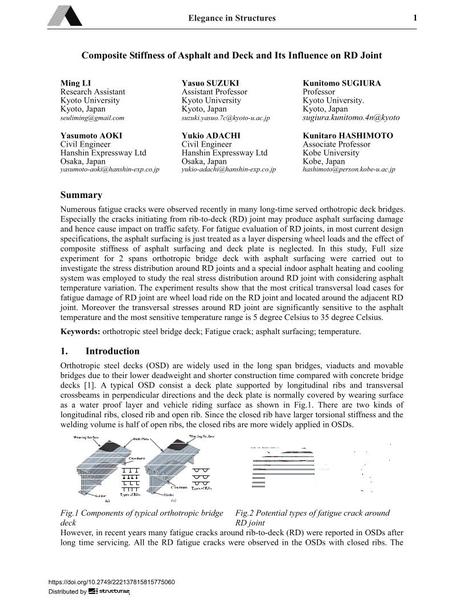Composite Stiffness of Asphalt and Deck and Its Influence on RD Joint

|
|
|||||||||||
Détails bibliographiques
| Auteur(s): |
Ming Li
Yasuo Suzuki Kunitomo Sugiura Yasumoto Aoki Yukio Adachi Kunitaro Hashimoto |
||||
|---|---|---|---|---|---|
| Médium: | papier de conférence | ||||
| Langue(s): | anglais | ||||
| Conférence: | IABSE Conference: Elegance in structures, Nara, Japan, 13-15 May 2015 | ||||
| Publié dans: | IABSE Conference Nara 2015 | ||||
|
|||||
| Page(s): | 284-285 | ||||
| Nombre total de pages (du PDF): | 8 | ||||
| Année: | 2015 | ||||
| DOI: | 10.2749/222137815815775060 | ||||
| Abstrait: |
Numerous fatigue cracks were observed recently in many long-time served orthotropic deck bridges. Especially the cracks initiating from rib-to-deck (RD) joint may produce asphalt surfacing damage and hence cause impact on traffic safety. For fatigue evaluation of RD joints, in most current design specifications, the asphalt surfacing is just treated as a layer dispersing wheel loads and the effect of composite stiffness of asphalt surfacing and deck plate is neglected. In this study, Full size experiment for 2 spans orthotropic bridge deck with asphalt surfacing were carried out to investigate the stress distribution around RD joints and a special indoor asphalt heating and cooling system was employed to study the real stress distribution around RD joint with considering asphalt temperature variation. The experiment results show that the most critical transversal load cases for fatigue damage of RD joint are wheel load ride on the RD joint and located around the adjacent RD joint. Moreover the transversal stresses around RD joint are significantly sensitive to the asphalt temperature and the most sensitive temperature range is 5 degree Celsius to 35 degree Celsius. |
||||
